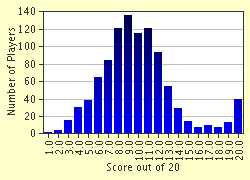Quiz Answer Key and Fun Facts
1. Following the re-discovery of this strange fish in 1938, JLB Smith (of the JLB Smith Institute) confirmed its identity as a Coelacanth and subsequently named the genus and species Latimeria chalumnae after Miss Marjorie Courtenay-Latimer and the place of its capture.
What was Miss Courtenay-Latimer's occupation?
2. The name Coelacanth is derived from the Greek words 'koilos' and 'akantha'. This roughly translates to which of the following?
3. The branch of zoology concerned with the study of the natural history of fishes is known as what?
4. The JLB Smith Institute has been renamed and has the initials S.A.I.A.B. What do those initials stand for?
5. The original 1938 Coelacanth specimen, found off the coast of South Africa, was around 1.50 m / 5 feet long and weighed just under 60kg / 130 pounds.
6. How many fins do Coelacanths have?
7. Coelacanth fossils have been found on every continent apart from Europe.
8. How long is the gestation period for the Coelacanth?
9. Coelacanth eggs are fertilised internally, and hatch inside the parent fish. The pups are born alive, some still attached to the yolk sac which provided nourishment throughout the embryonic growing phase inside their mother.
What is the name of the alternative reproductive method whereby the eggs are expelled and hatch outside the body?
10. It was once thought that unborn Coelacanth pups ate their siblings and other eggs while still in the uterus before birth, but this has since been disproven.
Cannibalistic behaviour of this sort is known as oophagy.
11. The eggs of the Coelacanth are the largest of all known fish. Roughly what is the size of each egg?
12. What proportion of the cranial cavity does the brain of an adult Coelacanth occupy?
13. What is the nickname that JLB Smith gave to the Coelacanth?
14. Fins with an internal skeleton structure such as those of the Coelacanth are known as which of the following?
15. The electro-receptive device in the snout of the Coelacanth which is used to locate prey is known as which organ?
16. Coelacanths go foraging for food by day and spend most of their nights resting up in caves.
17. A second species of Coelacanth has since been found to occupy the deep waters around Indonesia. When the first specimen was found just off North Sulawesi it was named Coelacanth Latimeria menadoensis. The people of Indonesia know their Coelacanth as "raja laut".
This roughly translates to which of the following?
18. Name the most obvious difference between the two species of Coelacanth?
19. Coelacanths feed mainly on algae.
20. Coelacanths are critically endangered and conservation efforts are underway to try and protect them. Even though they are released if caught accidentally, they cannot survive in the shallow waters for very long. This is because as deep water dwellers they have become accustomed to which of the following?
Source: Author
izzi
This quiz was reviewed by FunTrivia editor
crisw before going online.
Any errors found in FunTrivia content are routinely corrected through our feedback system.

